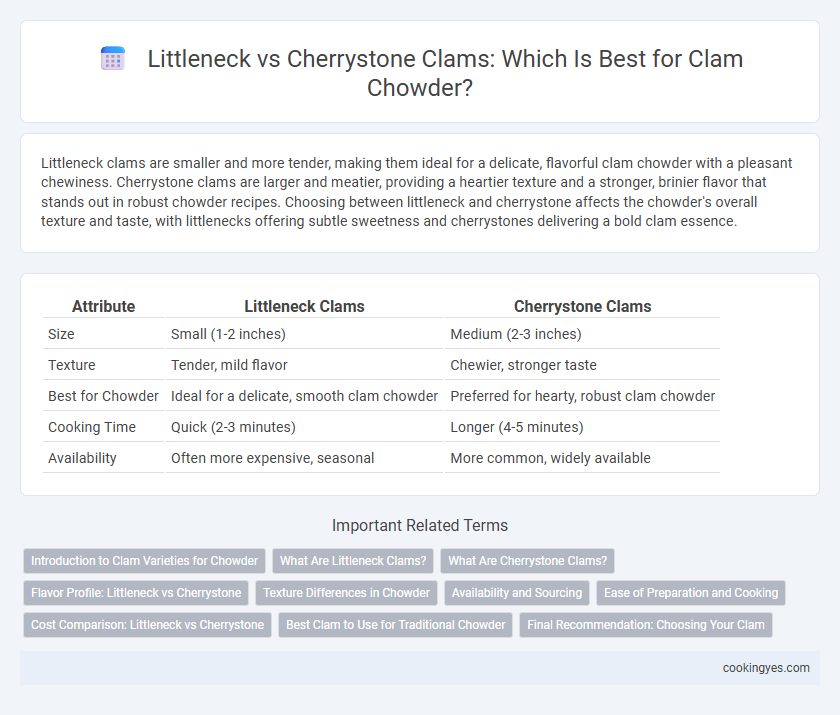Littleneck clams are smaller and more tender, making them ideal for a delicate, flavorful clam chowder with a pleasant chewiness. Cherrystone clams are larger and meatier, providing a heartier texture and a stronger, brinier flavor that stands out in robust chowder recipes. Choosing between littleneck and cherrystone affects the chowder's overall texture and taste, with littlenecks offering subtle sweetness and cherrystones delivering a bold clam essence.
Table of Comparison
| Attribute | Littleneck Clams | Cherrystone Clams |
|---|---|---|
| Size | Small (1-2 inches) | Medium (2-3 inches) |
| Texture | Tender, mild flavor | Chewier, stronger taste |
| Best for Chowder | Ideal for a delicate, smooth clam chowder | Preferred for hearty, robust clam chowder |
| Cooking Time | Quick (2-3 minutes) | Longer (4-5 minutes) |
| Availability | Often more expensive, seasonal | More common, widely available |
Introduction to Clam Varieties for Chowder
Littleneck clams, prized for their tender texture and sweet flavor, are ideal for a delicate clam chowder, offering a balance that highlights the broth's creamy base. Cherrystone clams are larger, providing a firmer bite and a more robust clam taste, perfect for chowders seeking a hearty, substantial clam presence. Both varieties contribute distinct textures and flavors, making the choice dependent on preferred chowder consistency and intensity of clam essence.
What Are Littleneck Clams?
Littleneck clams are a small, tender variety of hard-shell clam typically measuring up to 1.5 inches in diameter, prized for their sweet, briny flavor that enhances clam chowder richness. Their delicate texture and subtle taste make them ideal for chowders, as they cook quickly without becoming tough or rubbery. Often harvested from coastal regions in the northeastern United States, littlenecks are preferred over larger clams like cherrystones for a more refined, balanced clam chowder experience.
What Are Cherrystone Clams?
Cherrystone clams are medium-sized hard-shell clams measuring about 2 to 3 inches, prized for their firm texture and slightly briny flavor, making them ideal for hearty clam chowder. These clams offer more meat compared to smaller littlenecks, providing a robust chew that stands up well in creamy soups. Their size and flavor balance make cherrystones a popular choice for traditional New England clam chowder recipes.
Flavor Profile: Littleneck vs Cherrystone
Littleneck clams offer a sweeter, more delicate flavor that enhances clam chowder without overpowering the broth. Cherrystone clams have a meatier texture and a brinier, robust taste that contributes a deep, savory essence to the chowder. Choosing between littleneck and cherrystone clams depends on whether a subtle sweetness or a heartier clam presence is desired in the flavor profile.
Texture Differences in Chowder
Littleneck clams contribute a firm, tender texture to clam chowder, maintaining bite without becoming tough. Cherrystone clams, larger and meatier, offer a chewier, heartier mouthfeel that stands out in thicker chowders. Choosing between them depends on desired chowder consistency, with littlenecks preferred for a delicate texture and cherrystones for robust, textured clam pieces.
Availability and Sourcing
Littleneck clams are smaller and more abundant, often sourced from coastal waters of the Northeastern U.S., making them readily available for clam chowder recipes. Cherrystone clams are larger and less common, primarily harvested in the same regions but with more limited availability due to size and seasonality. The steady supply of littlenecks provides a consistent option for chowder, while cherrystones are typically chosen for a heartier texture when in season.
Ease of Preparation and Cooking
Littleneck clams are smaller and generally easier to clean, making them ideal for quick preparation in clam chowder recipes. Cherrystone clams, being larger and meatier, require more thorough cleaning and slightly longer cooking times to ensure tenderness. Using littlenecks can speed up the cooking process without sacrificing the clam's fresh flavor, perfect for convenient and efficient chowder preparation.
Cost Comparison: Littleneck vs Cherrystone
Littleneck clams typically cost more than cherrystone clams due to their smaller size and sweeter flavor, making them a premium choice for clam chowder. Cherrystones, being larger and more abundant, are generally more affordable, offering a budget-friendly option without sacrificing substantial texture. The price difference influences recipe choices, with littlenecks favored in upscale chowders and cherrystones preferred for hearty, cost-effective meals.
Best Clam to Use for Traditional Chowder
Littlenecks are considered the best clam for traditional clam chowder due to their tender texture and mildly sweet flavor, which enhances the broth without overpowering it. Cherrystones, while larger and meatier, can be tougher and are better suited for recipes requiring firmer clams rather than creamy chowders. Opting for littleneck clams ensures a classic, balanced taste and optimal tenderness in traditional New England clam chowder.
Final Recommendation: Choosing Your Clam
Littleneck clams offer a tender texture and sweeter flavor, making them ideal for chowders requiring a delicate clam presence. Cherrystone clams provide a firmer bite and robust taste, lending a heartier dimension to chowders that benefit from bold seafood flavors. For a balanced clam chowder, opt for littlenecks when prioritizing subtlety, or cherrystones if a meatier, more pronounced clam taste is desired.
Littleneck vs Cherrystone for clam chowder Infographic

 cookingyes.com
cookingyes.com